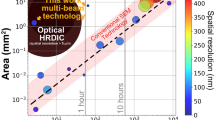Abstract
This study presents a novel method to quantify the effectiveness of wet magnetic particle inspection (MPI) when detecting possible defects. Wet MPI is an established method utilizing magnetic fields to locate possible areas of defects in ferromagnetic parts. The capability of this method has been evaluated in the past most notably using the probability of detection graphs. However, MPI requires a large amount of data and is subjective because it is based on human operators’ evaluation. The method proposed in this paper is an objective method to determine the effectiveness of the MPI test based on how well discontinuities can be delineated in the image. This approach utilizes the intensity of the particle illumination in the defect area and compares it to its surroundings. This analysis generates a value to objectively represent how well a discontinuity can be identified. This method was then used to validate the effect of surface roughness on the effectiveness of wet MPI using two experiments. The first experiment was conducted to test for the collection of particles on varying surface roughness levels, and the second experiment was used to evaluate the effect of surface roughness when detecting a subsurface discontinuity. Results indicate that there is a significant increase in particle collection as roughness increases, and as the surface roughness increases, the harder it is to locate discontinuities. This method provides a quantitative measure that could be used to aid parameter selection.












Similar content being viewed by others
References
J.Y. Lee, S.J. Lee, D.C. Jiles, M. Garton, R. Lopez, L. Brasche, Sensitivity analysis of simulations for magnetic particle inspection using the finite-element method. IEEE Trans. Magn. 39, 3604–3606 (2003)
M. Ibrahim et al., Magnetic flux leakage (MFL) capsule material selection and its robustness analysis in oil and gas pipeline. Sens. Transducers 156(9), 67 (2013)
D. Lovejoy, D. Lovejoy, “Magnetic Particles, Their Characteristics and Application,” in Magnetic Particle Inspection (Springer, Dordrecht, 1993).
M.A.A.A. Abd-Allah, “Determination of Length, Thickness and Elements of Some Samples defects By Using magnetic particles and Ultrasound testing”, 1–48 (2016)
“6 Advantages of Wet Suspension Magnetic Particle Testing,” Non-Destructive Testing (NDT) Blog–TSH. [Online]. Available: http://tspndt.com/non-destructive-testing-industrial-supplies-blog/6-advantages-of-wet-suspension-magnetic-particle-testing
M. Wright, “How to implement a PoD into a highly effective inspection strategy,” NDT Canada 2016 6th Int. CANDU In-Service Insp. Work. Nov 15-17, Burlington, (NDT Canada 2016)
C.A. Harding, G.R. Hugo, “Guidelines for interpretation of published data on probability of detection for nondestructive testing,” 1–20 (2011)
D. Lovejoy, D. Lovejoy, “The History and Basis of the Magnetic Particle Testing Method”, in Magnetic Particle Inspection (Springer, Dordrecht, 1993).
D. Lovejoy, D. Lovejoy, “Choosing a Magnetic Particle Inspection Method”, in Magnetic Particle Inspection (Springer, Dordrecht, 1993).
D.J. Eisenmann, D.D. Enyart, D.Kosaka, C.Lo, “Fundamental engineering studies of magnetic particle inspection and impact on standards and industrial practice,” (2014)
E. Li, Y. Kang, J. Tang, J. Wu, A new micro magnetic bridge probe in magnetic flux leakage for detecting micro-cracks. J. Nondestruct. Eval. 37(3), 46 (2018)
D. Schimpf, F. Peters, Variogram roughness method for casting surface characterization. Int. J. Met. (2020). https://doi.org/10.1007/s40962-020-00451-0
Acknowledgements
This research is sponsored by the DLA–Troop Support, Philadelphia, PA, and the Defense Logistics Agency Information Operations, J68, Research & Development, Ft. Belvoir, VA.
Author information
Authors and Affiliations
Corresponding author
Additional information
Publisher's Note
Springer Nature remains neutral with regard to jurisdictional claims in published maps and institutional affiliations.
Disclaimer: The publication of this material does not constitute approval by the government of the findings or conclusion herein. Wide distribution or announcement of this material shall not be made without specific approval by the sponsoring government activity.
Rights and permissions
About this article
Cite this article
Lau, S.M.Y., Eisenmann, D. & Peters, F.E. Development of an Image Analysis Protocol to Define Noise in Wet Magnetic Particle Inspection. Inter Metalcast 15, 1317–1325 (2021). https://doi.org/10.1007/s40962-020-00566-4
Received:
Accepted:
Published:
Issue Date:
DOI: https://doi.org/10.1007/s40962-020-00566-4




